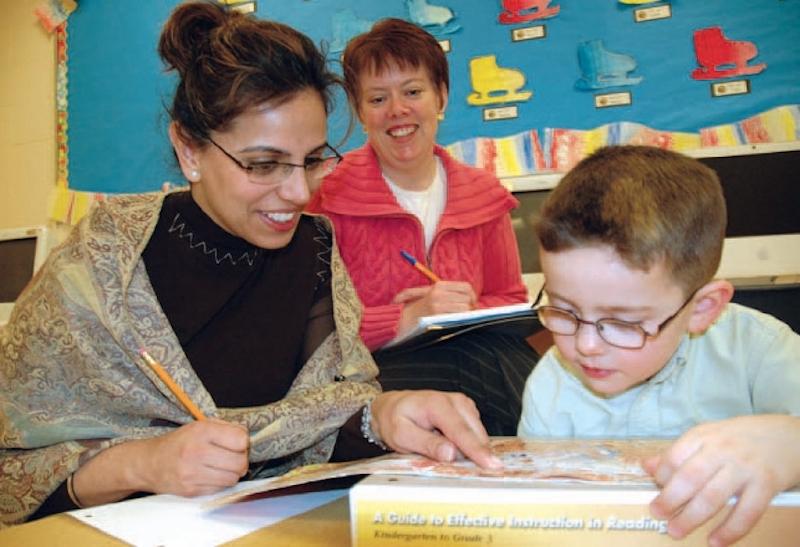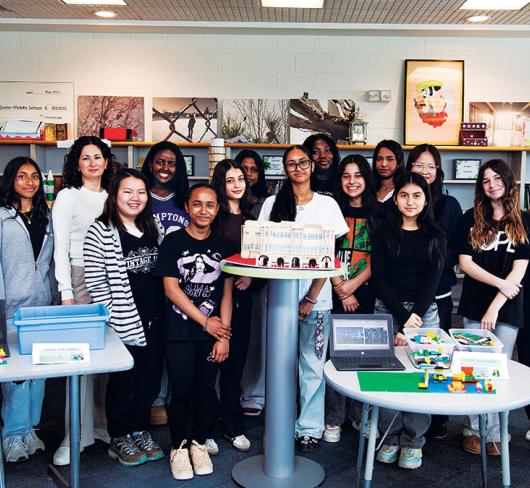
Imagining Leadership: Being the Best You can ... With the Help of a Coach
Last year Bobbie Chatha became a coach at her school, supporting colleagues as they looked for ways to improve literacy instruction.
Chatha’s school, W. T. Townsend, in Kitchener, was one of 15 schools in the Waterloo Region District School Board that began to use coaching to support student learning. The board’s consultants became interested in the coaching model after hearing from teachers who felt they never had time to implement the new strategies they learned about at professional development sessions.
The teachers’ experience reflected what research has shown. Bruce Joyce and Beverly Showers, among others, have demonstrated that about 5 percent of teachers apply what they learn in professional development activities to their classroom practice. However, when coaching accompanies professional development, the level of application increases to 90 percent.1
Coaching offered the Waterloo teachers a chance to have professional conversations about student learning. Many teachers felt that they needed strategies to help them navigate change and polish existing skills while they were trying to use the ideas expressed in the ministry guidelines and curriculum.
THE COACHING RELATIONSHIP
The coaches were volunteers, teachers who were interested in supporting learning at their school in one of three areas: Primary literacy, Junior literacy, and Primary mathematics. Bobbie Chatha shares this background: “I worked very closely with a number of teachers at my school even before I became a literacy coach. The staff recognized me as a supportive and knowledgeable colleague who was always willing to listen and help.”
Trish Betts-Malcolm, a senior kindergarten teacher, volunteered to work with Bobbie Chatha last year. She and Chatha met once a week for coaching sessions. “She worked with me to help me improve my literacy program and she shared many ideas and strategies. As a result I was able to put in place literacy work stations and guided reading in my classroom,” Betts- Malcolm says.
“With her help, my shared reading and writing lessons became much better organized, as did my running record data. Her ability to break huge tasks down into manageable pieces was one of the key reasons my program grew to be so successful. She demonstrated a variety of ways in which I could track my assessment, and how to plan using that valuable information.”
“Bobbie Chatha listened patiently to my questions and concerns and creatively sought ways to answer them. She provided the opportunity for me to watch her teach a small-group guided reading lesson and for her to watch me do the same. She planned our sessions so we were able to maximize my learning goals during our meetings while still maintaining flexibility in dealing with situations that arose for me during the week.”
“She made suggestions and set measurable goals, all without making me feel overwhelmed. I always left meetings knowing exactly what was expected from me for the following week.”
DIFFERENT SCHOOLS, DIFFERENT APPROACHES
Each school in the Waterloo program had a distinctive coaching model shaped by teachers’ needs. Because they were working at their own schools, coaches understood the school’s culture and goals and knew what resources were available.
One school focused on improving reading instruction. What started off as “everyone implementing guided reading” soon meant something different for every teacher. One teacher wanted to understand how to use data for flexible grouping; another wanted to really understand what the MSV analysis of running records was for. One teacher wanted to get a better understanding of what the other students were doing when the teacher was engaged in small group instruction; another teacher felt she wanted her students to experience a range of graphic organizers during shared reading before she felt ready to embark on small group instruction.
OPENING THE DOOR
A group of grade 7/8 teachers agreed to try a different model, one they called “Open Door.” Five teachers from five different schools visited and coached each other and are now developing a shared instructional focus.
Carolyn Baechler, a grade 7/8 teacher at Courtland Public School, started with an exploration of books on adolescent literacy. From that discussion, her group has worked on developing a common class profile. “The Open Door model means that we open our practice to a ‘trusted other,’ planning teaching strategies for specific learning needs, and observing the teaching and learning that results,” Baechler says.
“One of the greatest benefits is that it lets the fresh air of renewed teaching energy in! We can remind each other of effective strategies that we’ve forgotten about, ask guiding questions about the teaching and learning assumptions that we’ve been making, and generally encourage each other’s strong points.”
“The intentional conversations help to keep our perspectives on students from becoming entrenched.”
Mary Martin, who has been exploring teaching strategies with Baechler, explains: “It’s always beneficial to see the actual practice of a teaching/learning strategy, in a dynamic setting, rather than simply reading about it, or listening to it in an ‘eager beavers’ teacher workshop. It allows me to say, ‘I could do that!’”
COACHING THE COACHES
The coaches were themselves mentored by a lead coach, one for each of the three focus areas. These three teachers coached at their own schools and supported other coaches. They helped shape the role of the coach and the protocols of coaching, as well as developing strategies for tracking all the coaching activities.
Every coach was released for a half-day once a month, to engage in book study, role-play, problem solving, facilitation skills and relationship building, to refine their coaching skills. Coaches met monthly to share strategies and techniques.
LOOKING BACK, LOOKING AHEAD
Coaching is successful when coaches recognize that teachers who invite them into their classrooms are taking a risk. The coach provides a gentle mirror of reflection to help teachers recognize their strengths and help them make choices. The coach does not evaluate teacher performance. Discussions between the teacher and the coach remain private.
Many teachers who were initially skeptical have warmed to this professional learning strategy. They are welcoming the opportunity to learn and to have a second set of eyes and ears as they worked with their students. We all want to embrace hope as we face the exciting, unknown tomorrow in education. A coach can help many of us reach that goal.
1 Quoted in Powerfu Designs for Professiona Learning, L. B. Easton (ed.), Oxford, OH: Nationa Staff Deve opment Counci , 2004.

